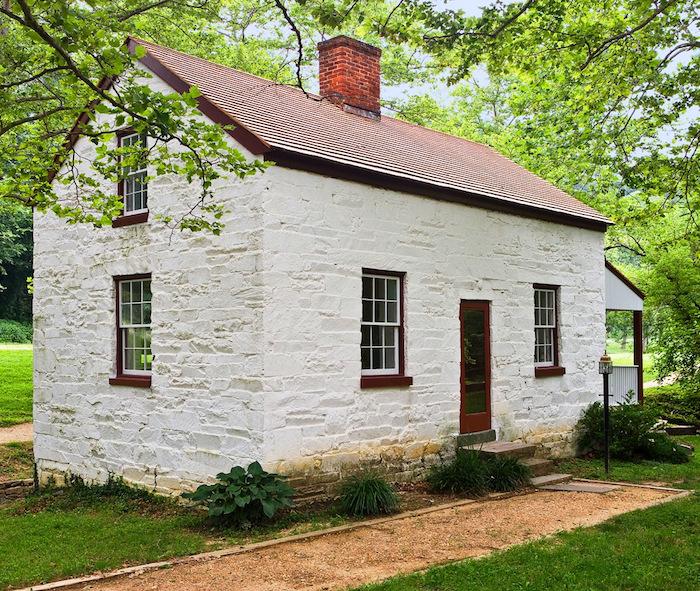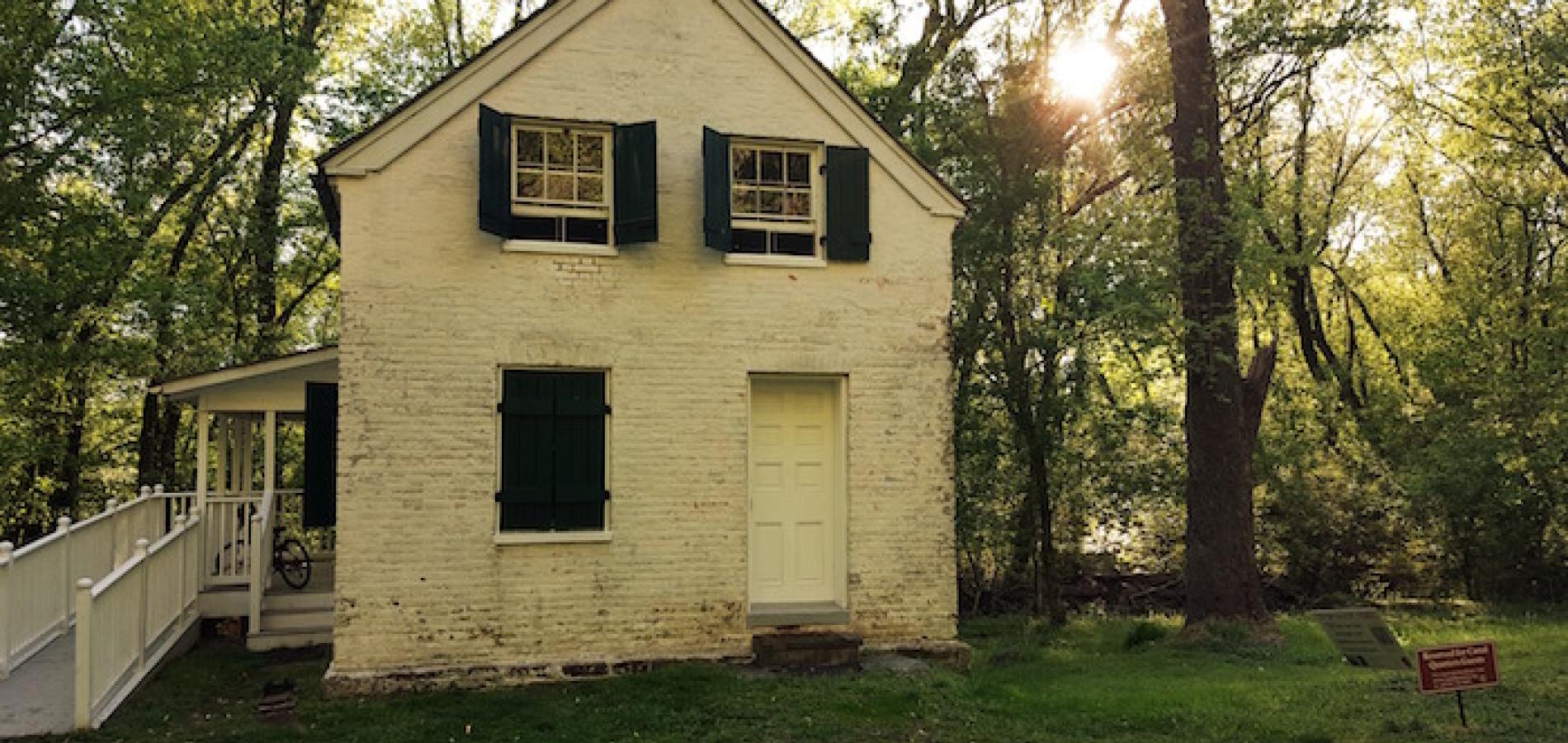Crossing the powder-blue bridge spanning the Potomac River at Point of Rocks, Maryland, I feel like I’ve time-warped to another century. With my husband and two children in tow, we have left behind the bustling Virginia suburbs of Washington, D.C., to stay in a historic lockhouse along the C&O Canal. For one weekend at least we hope to experience what life was like for a 19th-century lock tender and his family, whose livelihood was tied to the daily rhythms of moving boats and goods. If history had gone in a different direction, however, our stay would have been impossible.
Built between 1828 and 1850, the Chesapeake & Ohio Canal was a remarkable feat of engineering, designed to move coal and other products along the Potomac River from the mid- Atlantic ports to the Ohio River Valley, while bypassing difficult or impossible terrain, including the Great Falls of the Potomac and the Allegheny Mountains, part of the vast Appalachian range. The original plan was for both an eastern section from Washington to Cumberland, Maryland, and a western section that would traverse the Alleghenys to the Ohio River.
With the Baltimore & Ohio Railroad laying track concurrently in what became a sort of a transportation race, only the eastern section of the canal was completed, stretching for 184.5 miles from D.C.’s waterfront Georgetown neighborhood (and its proximity to the Chesapeake Bay) up to Cumberland, a little town tucked into a vale in the mountains. A series of 74 locks moved canal boats up and down the canal, which went from sea level in the District of Columbia up to about 600 feet of elevation in the mountains.

Lockhouse No. 28 requires a short hike to reach. Inside you’ll find unique architecture and an ambiance from decades long gone by/C&O Canal Trust
By 1924, a series of floods had closed sections of the canal, and operations were forced to cease. By the outbreak of World War II, the federal government had purchased the canal with the idea of turning it into a recreation area. This idea was quickly replaced by a National Park Service-supported plan to make a parkway along the path of the canal, destroying
it in the process. But a small group of advocates was determined that the canal would have a different fate.
Following a Justice’s Path
The sun has dipped low in the western sky when we park in a riverfront lot at Point of Rocks, which is named for a rugged rock formation jutting out of Catoctin Mountain. We shoulder our packs and carry our lanterns and sleeping bags for the half-mile hike on the canal towpath toward our destination—Lockhouse 28, located at about milepost 49 (the towpath begins at milepost zero in Georgetown).
It was on this same path that William O. Douglas, an Associate Justice of the Supreme Court, led a hike the entire length of the canal to advocate for keeping the canal as a historic site and recreation area. The walk began in Cumberland on March 20, 1954, with 58 hikers, including conservationists and members of the press. Only nine hikers, including Douglas, finished the entire length. It would take many more years of advocacy before Congress finally designated the Cheasapeake & Ohio Canal National Historical Park in 1971, preserving the canal, the towpath, and dozens of historic structures, including lockhouses, tunnels, and aqueducts.

The fine architecture of years gone past is on display in the lockhouses, such as in this one, No. 22 / C&O Canal Trust
Dating to 1837, Lockhouse 28 is one of six lockhouses now available for rent from the C&O Canal Trust, the park’s nonprofit partner. In addition to being one of the most rustic, with no running water or electricity (but a well-maintained Porta-John to one side), Lockhouse 28 is the most remote, the only one requiring a pack-in hike. Other lockhouses are spread throughout the length of the canal from milepost 5 to 108, and are restored to depict different time periods up through the 1950s. Some have electricity or full amenities.
As the late-afternoon sun bathes the trees in shades of gold and green, we hike toward the house in near solitude, accompanied only by chirping birds and the occasional hellos of passing hikers and cyclists. My shoulders relax, and I feel grateful for Justice Douglas’s perseverance.
Starlight and Fireflies
After about 15 minutes of hiking (it’s slow going with our packs and puttering children), we arrive at the lockhouse, a charming white cottage with green shutters. The towpath runs between the lockhouse and the extant lock, now full of vegetation instead of water. My kids immediately begin investigating the grounds, which include a short winding trail down to the Potomac in one direction and a path leading up to the adjacent railroad line as well. Because of the narrow strip of land between the cliffside and the river here, the railroad and the canal fought over the rights of way in court for years; the resulting proximity must have felt a little uneasy at times. Not long after we arrive, we get a thrill when a CSX freight train lumbers past, the horn blowing as it goes.
As my husband starts a fire in the ring near the house, we check out the interior. The lockhouse is sparsely furnished with a simple wooden table and hutch in the dining room, and a long bench and two classic stick-back rocking chairs in the adjoining living room. Upstairs are two bedrooms with two beds apiece, with trundles tucked beneath. Historic photos of the lockhouse and the railroad help to put the place into context.

Lockhouse No. 6, below, has been restored to how it appeared in the 1950s, when Justice William O. Douglas led his crusade to preserve the landscape / C&O Canal Trust
We roast hot dogs over the fire, and we entertain a few visitors. Nearly every person who hikes or bikes past stops to ask questions about the lockhouse, and we happily become de facto docents. As night falls, we are startled to realize that the woods all around us are full of glowing fireflies. The sky fills with stars we don’t often see back in the city. We sleep soundly in the solid masonry building, with only the rumbling of the occasional train to stir us.
Justice Douglas, in one of his pleas for protection of the canal, wrote, “It is a refuge, a place of retreat, a long stretch of quiet and peace.” After a weekend spent together in the charming lockhouse, hiking along the towpath, cooking over the fire, playing board games by lantern light, we couldn’t agree more.
Kim O’Connell’s articles, essays, and short fiction have appeared in The Washington Post, The New York Times, Ladies Home Journal, National Geographic News, National Parks, Little Patuxent Review, and more. She has been a writing fellow at the Virginia Center for the Creative Arts and was the first writer-inresidence at Shenandoah National Park. She teaches in the Johns Hopkins University M.A. in Science Writing Program.



 Support Essential Coverage of Essential Places
Support Essential Coverage of Essential Places






